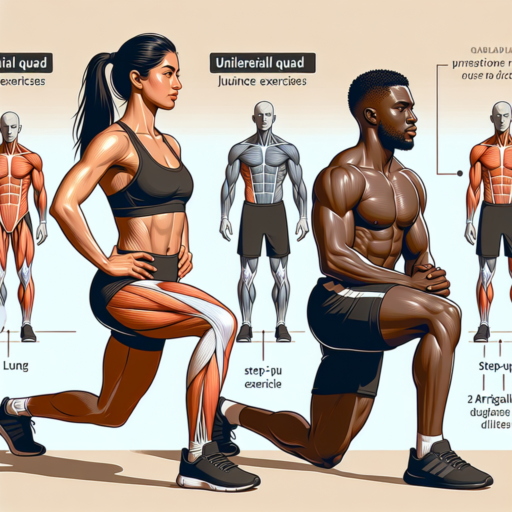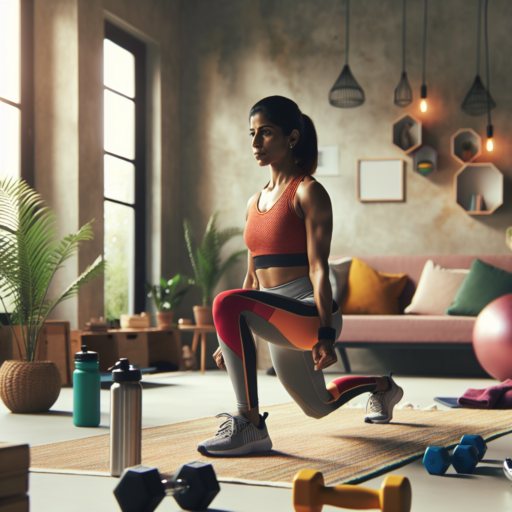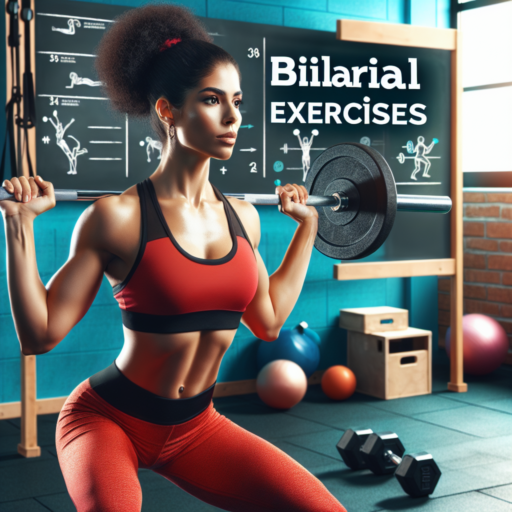Introduction to Unilateral Quad Exercises
Unilateral quad exercises represent a cornerstone of balanced lower body strength training, focusing on engaging one leg at a time. Unlike bilateral exercises, which work both legs simultaneously, unilateral movements challenge stability, balance, and coordination while also isolating and addressing imbalances in muscle strength. Such exercises are particularly beneficial for athletes, rehabilitation, and anyone looking to improve functional movement.
One of the key benefits of unilateral quad exercises is their ability to mimic real-world activities and sports-specific movements. This direct application enhances proprioception—our sense of body position, movement, and equilibrium—thereby improving overall athletic performance. Moreover, by isolating one leg at a time, these exercises ensure that both legs develop evenly, reducing the risk of injuries caused by muscle imbalances. Incorporating unilateral exercises into your routine can lead to better joint health, increased core engagement, and more efficient movement patterns in day-to-day activities.
Examples of unilateral quad exercises include lunges, single-leg squats, and step-ups. Each of these exercises can be modified or progressed to meet individual fitness levels, making them suitable for both beginners and advanced athletes. By focusing on one leg at a time, individuals can also identify and correct weaknesses, contributing to stronger, more resilient quadriceps and lower body muscles.
The Benefits of Unilateral Training for Quads
Unilateral training, focusing on one limb or side of the body at a time, brings significant benefits, especially when it comes to strengthening and developing the quadriceps. This approach can lead to remarkable increases in muscle size, strength, and symmetry, making it a compelling choice for athletes and fitness enthusiasts alike.
The first and perhaps most compelling benefit of unilateral training for quads is the enhanced muscle activation. By isolating each quad, you’re able to concentrate your effort and stimulate more muscle fibers, leading to improved muscle growth and strength. This aspect is particularly beneficial for those looking to overcome strength imbalances between legs.
Improved Balance and Coordination
Another significant advantage is the improvement in balance and coordination. Unilateral exercises require not just strength, but also a great deal of stability and control. This can help improve your overall athletic performance, as well as your capability to perform daily activities with more ease and less risk of injury.
Reduction in Injury Risk
Moreover, engaging in unilateral training can lead to a reduction in the risk of injury. By correcting imbalances and strengthening the muscles around the knees and hips, you are less likely to suffer from common injuries associated with weak or imbalanced quads. This preventive aspect makes unilateral quad exercises a wise addition to any training routine.
Top 5 Unilateral Quad Exercises for Strength and Balance
Unilateral quad exercises are essential for building strength, improving balance, and correcting muscular imbalances. By focusing on one leg at a time, these exercises challenge your stability and enhance coordination, making them a vital addition to any fitness regimen. Below, explore the top 5 unilateral exercises that target your quads for a more balanced and powerful lower body.
Bulgarian Split Squats
The Bulgarian split squat is a powerhouse movement for targeting the quadriceps, glutes, and improving overall balance. By elevating your rear foot on a bench or step, and focusing on lowering your hips straight down, this exercise ensures a significant contraction and stretch in the quad muscle of the front leg. Proper form and controlled movements are crucial for maximizing benefit and minimizing injury risk.
Single-Leg Press
Traditionally performed on a leg press machine, the single-leg press focuses the effort on one quad at a time, promoting muscle balance and joint stability. Adjust the seat and platform to ensure that your knee is safe and you are able to push through with full range of motion. A consistent, slow pace maximizes tension in the quads, reinforcing strength gains and enhancing muscular endurance.
Step-Ups
Step-ups are a functional exercise that mimic everyday movements, making them an excellent option for unilateral training. Using a bench or step, this exercise engages the quad of the stepping leg, while also involving the glute muscles for a complete lower-body workout. Focus on driving through your heel to increase the intensity of the quad workout, and keep your chest up to maintain balance and posture.
These unilateral exercises not only improve the strength and balance of your quadriceps but also contribute to a symmetrical lower body development, ensuring that both legs are equally strong and capable. Incorporating these movements into your routine will help you achieve a well-rounded and powerful physique.
How to Properly Perform Unilateral Quad Exercises
Unilateral quad exercises target one leg at a time, providing focused muscle engagement and strength gains. These exercises are essential for correcting muscle imbalances, improving balance, and enhancing athletic performance. To properly perform unilateral quad exercises, it’s crucial to maintain proper form, balance, and focus on the targeted muscles.
Starting with the Basics
Begin with foundational exercises like the single-leg squat or lunge. Ensure your knee is aligned with your foot, preventing it from extending beyond your toes to minimize stress on the joint. Keeping your core engaged is vital for stability. It’s also important to keep your hips level during the exercise to fully engage the quad muscles without straining surrounding muscles.
Progress Slowly and Steadily
Increase difficulty gradually by adding weight or resistance, but only once you can perform exercises with perfect form. Using dumbbells or a kettlebell can enhance the strength-building benefits of these exercises. Additionally, incorporating balance challenges, such as performing exercises on an unstable surface, can further improve the efficacy of your training.
Focus on the quality of each movement rather than the quantity. Performing unilateral quad exercises slowly and with control ensures that the muscle fibers are fully engaged, leading to better strength development and the reduction of injury risk. Listening to your body and adjusting as necessary is key to successful and safe unilateral quad training.
Incorporating Unilateral Quad Exercises into Your Workout Routine
When looking to enhance your leg day, unilateral quad exercises are an essential component to consider for balanced muscle development and improved functionality. These exercises focus on one leg at a time, allowing for a more concentrated effort and addressing any imbalances between the two sides. By incorporating unilateral movements into your routine, you can not only increase the strength and size of your quads but also improve your performance in bilateral movements and daily activities.
Benefits of Unilateral Quad Exercises include heightened muscle activation and the promotion of symmetrical muscle growth. By isolating each leg, these exercises ensure that both quads work equally hard, preventing the dominant side from taking over. This approach is incredibly beneficial for athletes and fitness enthusiasts looking to enhance their agility, balance, and coordination. Furthermore, unilateral exercises can significantly reduce the risk of injuries by improving joint stability and reinforcing proper movement patterns.
Integrating unilateral quad exercises into your workout routine doesn’t have to be complex. Start with simpler movements like single-leg squats or lunges before progressing to more challenging exercises such as the Bulgarian split squat or the single-leg press. It’s crucial to pay close attention to your form, maintaining a slow and controlled movement to maximize muscle engagement and effectiveness. As you become more comfortable with these exercises, gradually increase the intensity by adding weights or resistance, ensuring consistent progress in your quad development.
Advanced Unilateral Quad Exercises for Experienced Athletes
Unilateral exercises, which involve training one limb or side of the body at a time, are pivotal for correcting imbalances, enhancing coordination, and improving athletic performance. For experienced athletes seeking to target their quadriceps—the powerhouse muscles at the front of the thigh—advanced unilateral quad exercises offer a relentless challenge and unmatched gains. These exercises not only increase muscle strength and size but also enhance stability and overall functional fitness.
Focusing on one leg at a time allows athletes to dedicate all their effort and attention to the working leg, leading to more concentrated muscle engagement and improved balance. This, in turn, translates to better symmetry and muscle development, a crucial factor for high-level athletic performance. Moreover, unilateral quad exercises reduce the strain on the spine and lower back, providing a safe yet effective way to boost leg power.
Key Benefits of Unilateral Quad Training
- Increases Muscle Symmetry: Helps in correcting strength imbalances between legs, ensuring equal power and functionality.
- Enhances Core Stability: Each exercise demands significant core engagement to maintain balance, thereby strengthening abdominal and lower back muscles.
- Improves Functional Performance: Mimics real-world activities and sports movements, improving athletes’ performance in their specific sports disciplines.
Incorporating these advanced unilateral quad exercises into your training regimen can lead to significant improvements in leg strength, balance, and athletic performance. By addressing muscular imbalances and focusing on the development of each leg, athletes can achieve a more balanced and powerful lower body, setting a solid foundation for enhanced sports performance and reduced injury risk.
Common Mistakes and How to Avoid Them in Unilateral Quad Workouts
When embarking on unilateral quad workouts, it’s crucial to mind your form and workout structure to maximize benefits and minimize injury risks. Some common pitfalls often result from a lack of understanding or neglecting small yet significant details in your routine.
Ignoring Proper Warm-Up Routines
One of the most significant mistakes is skipping or inadequately performing warm-up exercises. A proper warm-up increases blood flow to your muscles, preparing them for the demanding workout ahead, and significantly reduces the risk of injury. Incorporate dynamic stretches and light cardio exercises focusing on your legs to fully prepare your quads for unilateral exercises.
Focusing Solely on Weight Rather Than Form
Another common pitfall is prioritizing weight-over-form. It’s tempting to lift heavier to feel more accomplished, but without the correct form, you’re not only compromising the effectiveness of your workout but also increasing your injury risk. Ensure you’re performing each exercise with proper alignment and balance, paying close attention to your knee positioning to avoid strain. It’s often helpful to work with a lower weight until you can perform each rep with impeccable form.
Omitting Unilateral Exercises from Your Routine
Ironically, a prevalent mistake in unilateral quad workouts is the complete omission of unilateral exercises. Focusing too much on bilateral movements may lead to muscle imbalances and overlooked strength discrepancies between legs. Incorporating unilateral exercises such as lunges and single-leg presses helps promote balanced muscle development and improves your overall leg strength and stability. Ensure to evenly work both legs to foster symmetrical strength growth.
Unilateral vs. Bilateral Quad Exercises: Understanding the Differences
When it comes to strengthening the quadriceps, the muscles at the front of your thigh, incorporating both unilateral and bilateral exercises into your routine can provide comprehensive benefits. Understanding the differences between these two types of exercises is crucial for developing a well-rounded leg training program. Unilateral exercises involve activating one leg at a time, while bilateral exercises engage both legs simultaneously. This fundamental distinction affects muscle recruitment, balance, and the intensity of the workout.
Benefits of Unilateral Quad Exercises
Unilateral quad exercises, such as lunges and single-leg squats, focus on one leg at a time. This approach helps to correct muscle imbalances and increases muscle activation on the working leg. It also enhances core stabilization and balance, as your body is forced to maintain stability while a single leg performs the exercise. The key benefit of unilateral training is its ability to isolate and strengthen each leg independently, making it an essential component for athletes or individuals recovering from injury.
Benefits of Bilateral Quad Exercises
Bilateral quad exercises, like squats and leg presses, engage both legs at the same time. This allows for the lifting of greater weights, leading to potential increases in overall strength and muscle mass. Bilateral exercises are fundamental for building a solid strength foundation, as they simulate many everyday movements and athletic skills. Additionally, these exercises tend to require less coordination and balance than unilateral options, making them more accessible to beginners.
While both unilateral and bilateral quad exercises offer unique benefits, integrating them into your leg training routine can lead to a more balanced and comprehensive development of the quadriceps. Choose exercises based on your fitness goals, physical condition, and training preferences to maximize the benefits of your leg workouts.
No se han encontrado productos.
FAQs About Unilateral Quad Exercises
Unilateral quad exercises are gaining popularity among fitness enthusiasts for their unique benefits over traditional bilateral movements. A common query revolves around why one might prefer unilateral exercises for the quadriceps. Simply put, these exercises can enhance muscular balance and coordination, reduce the risk of injury by identifying and correcting imbalances, and even promote greater strength and muscle gains by isolating and targeting the quads more effectively.
Another frequently asked question concerns the most effective unilateral quad exercises. Common recommendations include the Bulgarian split squat, single-leg press, and step-ups. These specific movements are celebrated for their ability to intensify focus on the quadriceps, offering a deeper contraction and more focused muscle engagement. Additionally, this type of training can improve core stability as the body works to maintain balance.
Fitness enthusiasts often inquire about how often one should incorporate unilateral quad exercises into their regimen. While individual needs may vary, a general guideline is to include unilateral work 1-2 times per week. This allows for sufficient stimulus for growth and strength improvements while ensuring recovery and preventing overuse injuries. It’s crucial to listen to your body and adjust frequency based on personal progress and goals.
Success Stories: The Impact of Unilateral Quad Exercises on Personal Fitness Goals
When it comes to enhancing personal fitness and achieving remarkable milestones, unilateral quad exercises play a pivotal role. These targeted movements focus intensely on one leg at a time, ensuring that your quads receive undivided attention and effort. This spotlight on individual muscle groups not only promotes muscle balance and symmetry but also addresses strength disparities between limbs. Success stories from fitness enthusiasts and athletes alike highlight the transformative power of integrating unilateral quad exercises into their routines.
Increased Strength and Stability are among the most celebrated outcomes of unilateral quad exercises. Individuals who have incorporated exercises such as lunges and single-leg squats into their fitness regimes report significant improvements in leg strength. Noteworthy is the fact that these enhancements aren’t just in muscle power but also in enhanced stability and agility. Such attributes are crucial for athletes who require both power and precision in their sport.
Furthermore, the rehabilitative impact of unilateral quad exercises cannot be overlooked. Those recovering from injuries have shared success stories of how these exercises facilitated not just a swift return to baseline strength but also how they surpassed their pre-injury fitness levels. By isolating and working on one leg at a time, these exercises ensure that the injured limb does not lag behind in strength, thereby promoting a more balanced recovery.




